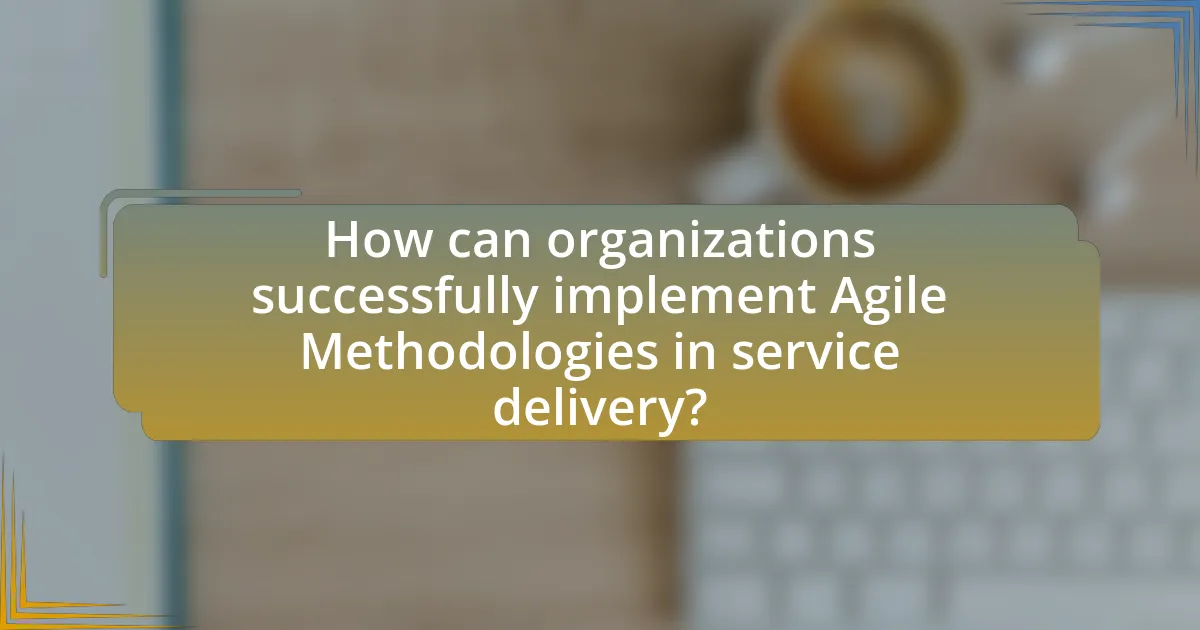Agile methodologies in service delivery are frameworks designed to enhance service quality and responsiveness through iterative development, collaboration, and flexibility. This article explores the differences between Agile and traditional service delivery approaches, highlighting key principles and values that drive Agile practices. It discusses the importance of implementing Agile methodologies for improved customer satisfaction and project success rates, as well as the essential roles within Agile teams and common frameworks like Scrum and Kanban. Additionally, the article addresses challenges organizations face without Agile, strategies for successful implementation, and best practices for continuous improvement in service delivery.

What are Agile Methodologies in Service Delivery?
Agile methodologies in service delivery are frameworks that promote iterative development, collaboration, and flexibility to enhance service quality and responsiveness. These methodologies, such as Scrum and Kanban, emphasize continuous improvement and customer feedback, allowing teams to adapt quickly to changing requirements. Research indicates that organizations implementing Agile methodologies experience increased efficiency and customer satisfaction, as they can deliver services more rapidly and effectively. For instance, a study by the Project Management Institute found that 71% of organizations using Agile reported improved project success rates.
How do Agile Methodologies differ from traditional service delivery approaches?
Agile methodologies differ from traditional service delivery approaches primarily in their flexibility and iterative nature. Agile emphasizes adaptive planning, evolutionary development, and early delivery, allowing teams to respond to changes quickly and effectively. In contrast, traditional approaches, often characterized by a linear and sequential process, follow a fixed plan where changes can be costly and time-consuming. For instance, the Agile Manifesto promotes collaboration and customer feedback throughout the development process, which contrasts with the traditional focus on comprehensive documentation and upfront requirements. This fundamental difference enables Agile teams to deliver value incrementally, enhancing customer satisfaction and project adaptability.
What principles define Agile Methodologies?
Agile methodologies are defined by twelve key principles outlined in the Agile Manifesto. These principles emphasize customer satisfaction through early and continuous delivery of valuable software, welcoming changing requirements even late in development, and delivering working software frequently. They also prioritize collaboration between business stakeholders and developers, support motivated individuals by providing the environment and support they need, and encourage face-to-face communication as the most effective method of conveying information. Agile methodologies advocate for sustainable development, maintaining a constant pace indefinitely, and technical excellence along with good design to enhance agility. Lastly, they promote simplicity—the art of maximizing the amount of work not done—and self-organizing teams that produce the best architectures, requirements, and designs. These principles collectively aim to improve service delivery by fostering adaptability, collaboration, and efficiency in software development processes.
How do Agile values influence service delivery?
Agile values significantly influence service delivery by prioritizing customer collaboration, responsiveness to change, and iterative progress. These values foster a culture where teams focus on delivering functional increments of service that meet customer needs, allowing for continuous feedback and adaptation. For instance, the Agile Manifesto emphasizes “customer collaboration over contract negotiation,” which leads to services being tailored more closely to user requirements, enhancing satisfaction and engagement. Additionally, Agile’s principle of “responding to change over following a plan” enables teams to pivot quickly in response to evolving customer demands or market conditions, ensuring that service delivery remains relevant and effective. This adaptability is supported by practices such as regular sprint reviews and retrospectives, which facilitate ongoing improvement and alignment with customer expectations.
Why is implementing Agile Methodologies important for service delivery?
Implementing Agile Methodologies is important for service delivery because it enhances responsiveness to customer needs and improves overall service quality. Agile practices, such as iterative development and continuous feedback, allow teams to adapt quickly to changing requirements, ensuring that services remain relevant and effective. Research indicates that organizations using Agile methodologies can achieve up to 30% faster delivery times and a 25% increase in customer satisfaction, as reported in the “State of Agile” survey by VersionOne. This adaptability and focus on customer collaboration are critical for maintaining competitive advantage in dynamic markets.
What challenges do organizations face without Agile?
Organizations face significant challenges without Agile methodologies, including reduced flexibility, slower response times to market changes, and increased difficulty in managing project scope. Without Agile, organizations often struggle to adapt to evolving customer needs, leading to a misalignment between product offerings and market demands. Research indicates that companies using Agile report a 30% improvement in project success rates compared to those that do not adopt Agile practices. Additionally, traditional project management approaches can result in longer development cycles, which may hinder competitiveness in fast-paced industries.
How does Agile improve responsiveness to customer needs?
Agile improves responsiveness to customer needs by promoting iterative development and continuous feedback. This approach allows teams to quickly adapt to changing requirements and customer feedback, ensuring that the final product aligns closely with customer expectations. For instance, Agile methodologies, such as Scrum, involve regular sprint reviews where stakeholders can provide input, leading to timely adjustments in the project. Research indicates that organizations implementing Agile report a 30% increase in customer satisfaction due to this enhanced adaptability and responsiveness.

What are the key components of Agile Methodologies in service delivery?
The key components of Agile Methodologies in service delivery include iterative development, collaboration, customer feedback, and adaptive planning. Iterative development allows teams to deliver work in small, manageable increments, facilitating continuous improvement. Collaboration emphasizes teamwork and communication among cross-functional teams, ensuring that all stakeholders are aligned. Customer feedback is integral, as it enables teams to adjust their services based on user needs and preferences, enhancing satisfaction. Adaptive planning allows for flexibility in response to changing requirements, ensuring that the service delivery process remains relevant and effective. These components collectively enhance the efficiency and responsiveness of service delivery in Agile environments.
What roles are essential in an Agile service delivery team?
The essential roles in an Agile service delivery team include the Product Owner, Scrum Master, and Development Team members. The Product Owner is responsible for defining the product vision and prioritizing the backlog, ensuring that the team delivers maximum value. The Scrum Master facilitates the Agile process, removes impediments, and ensures that the team adheres to Agile principles. Development Team members are responsible for delivering the product increment, collaborating closely to achieve the sprint goals. These roles are critical for effective Agile implementation, as they promote collaboration, accountability, and continuous improvement within the team.
How do these roles collaborate to enhance service delivery?
Roles such as product owners, scrum masters, and development teams collaborate by maintaining clear communication and shared goals to enhance service delivery. Product owners define the vision and prioritize the backlog, ensuring that the development team focuses on delivering high-value features. Scrum masters facilitate the agile process, removing obstacles and fostering a collaborative environment, which allows the development team to work efficiently. This collaboration leads to iterative improvements and faster delivery cycles, as evidenced by studies showing that organizations implementing agile methodologies can increase their delivery speed by up to 50%.
What skills are necessary for team members in Agile environments?
Team members in Agile environments require strong collaboration, adaptability, and communication skills. Collaboration is essential as Agile emphasizes teamwork and collective problem-solving, enabling members to work effectively towards shared goals. Adaptability is crucial because Agile methodologies often involve changing requirements and priorities, necessitating team members to adjust quickly to new information or challenges. Communication skills are vital for articulating ideas, providing feedback, and ensuring transparency among team members, which fosters a productive work environment. These skills collectively enhance the team’s ability to deliver high-quality results in a dynamic setting.
What frameworks are commonly used in Agile service delivery?
Common frameworks used in Agile service delivery include Scrum, Kanban, and Lean. Scrum is characterized by its iterative approach and defined roles such as Scrum Master and Product Owner, facilitating regular feedback and adaptation. Kanban focuses on visualizing work in progress and optimizing flow, allowing teams to manage tasks efficiently. Lean emphasizes eliminating waste and maximizing value, promoting continuous improvement. These frameworks are widely adopted due to their effectiveness in enhancing collaboration, flexibility, and responsiveness in service delivery environments.
How does Scrum facilitate Agile service delivery?
Scrum facilitates Agile service delivery by providing a structured framework that promotes iterative progress, collaboration, and flexibility. This framework includes defined roles, such as the Scrum Master and Product Owner, which ensure accountability and clear communication among team members. Scrum employs time-boxed iterations called sprints, allowing teams to deliver functional increments of the service regularly, typically every two to four weeks. This regular delivery enables teams to gather feedback quickly and adapt to changing requirements, enhancing customer satisfaction and responsiveness.
Additionally, Scrum incorporates ceremonies like daily stand-ups, sprint planning, and retrospectives, which foster continuous improvement and alignment within the team. These practices ensure that all team members are aware of progress and challenges, facilitating proactive problem-solving. The empirical process control inherent in Scrum, which relies on transparency, inspection, and adaptation, further supports Agile principles by allowing teams to make informed decisions based on real-time data and experiences.
What is the role of Kanban in managing service workflows?
Kanban plays a crucial role in managing service workflows by visualizing tasks and optimizing flow. This method allows teams to see work in progress, identify bottlenecks, and prioritize tasks effectively, leading to improved efficiency and responsiveness. Research indicates that organizations implementing Kanban experience a 20-50% increase in productivity due to enhanced visibility and reduced cycle times. By limiting work in progress, Kanban helps teams focus on completing tasks before taking on new ones, which further streamlines service delivery and enhances overall performance.

How can organizations successfully implement Agile Methodologies in service delivery?
Organizations can successfully implement Agile Methodologies in service delivery by fostering a culture of collaboration, continuous improvement, and customer-centricity. This involves training teams in Agile principles, such as iterative development and adaptive planning, which enhance responsiveness to change. Research indicates that organizations adopting Agile practices report a 30% increase in project success rates, as seen in the 2020 State of Agile Report by VersionOne. Additionally, integrating tools that support Agile workflows, such as Kanban boards and Scrum frameworks, facilitates transparency and accountability among team members. By prioritizing regular feedback loops with stakeholders, organizations can ensure that service delivery aligns with customer needs, ultimately leading to improved satisfaction and efficiency.
What steps should organizations take to transition to Agile?
Organizations should take the following steps to transition to Agile: first, they must assess their current processes and culture to identify areas for improvement. This assessment should include evaluating team dynamics, existing workflows, and stakeholder engagement. Next, organizations should provide Agile training for all team members to ensure a shared understanding of Agile principles and practices, which is crucial for effective implementation.
Following training, organizations should establish cross-functional teams that can collaborate effectively, as Agile emphasizes teamwork and communication. Implementing Agile frameworks, such as Scrum or Kanban, is the next step, allowing teams to adopt iterative development and continuous feedback loops.
Finally, organizations should foster a culture of continuous improvement by regularly reviewing processes and outcomes, encouraging teams to adapt and evolve their practices based on lessons learned. Research indicates that organizations that adopt these steps can improve project delivery times by up to 30% and enhance team satisfaction, as reported in the 2020 State of Agile report by VersionOne.
How can leadership support the Agile transformation process?
Leadership can support the Agile transformation process by fostering a culture of collaboration and continuous improvement. This involves actively promoting Agile principles, such as customer focus and iterative development, while also providing the necessary resources and training for teams. Research indicates that organizations with strong leadership support during Agile transformations experience a 30% higher success rate compared to those without such backing, as leaders help to remove obstacles and empower teams to make decisions. By modeling Agile behaviors and encouraging open communication, leadership can significantly enhance the effectiveness of Agile methodologies in service delivery.
What training is necessary for teams adopting Agile practices?
Teams adopting Agile practices require training in Agile methodologies, including Scrum, Kanban, and Lean principles. This training equips team members with the necessary skills to implement Agile frameworks effectively, fostering collaboration, adaptability, and iterative development. Research indicates that organizations with trained Agile teams experience a 20-30% increase in productivity and a 25% improvement in project success rates, as highlighted in the “State of Agile” report by VersionOne. This evidence underscores the importance of structured training in achieving successful Agile adoption.
What common pitfalls should organizations avoid during implementation?
Organizations should avoid inadequate stakeholder engagement during implementation. Failing to involve key stakeholders can lead to misalignment of goals and resistance to change, ultimately undermining the success of Agile methodologies. Research indicates that projects with high stakeholder engagement are 20% more likely to succeed, as they foster collaboration and ensure that the needs of all parties are addressed. Additionally, neglecting proper training for team members can result in confusion and ineffective use of Agile practices, which can hinder productivity and morale. According to the Project Management Institute, organizations that invest in training see a 25% improvement in project outcomes.
How can resistance to change be managed effectively?
Resistance to change can be managed effectively by fostering open communication and involving stakeholders in the change process. Engaging employees through transparent discussions about the reasons for change and its benefits can reduce uncertainty and build trust. Research indicates that organizations that prioritize communication during transitions experience 70% higher employee engagement and commitment (Kotter, 1996). Additionally, providing training and support helps employees adapt to new methodologies, further mitigating resistance. By addressing concerns and demonstrating the positive impact of agile methodologies, organizations can create a more receptive environment for change.
What strategies can ensure continuous improvement in Agile practices?
To ensure continuous improvement in Agile practices, organizations should implement regular retrospectives, foster a culture of feedback, and utilize metrics for performance tracking. Regular retrospectives allow teams to reflect on their processes and identify areas for enhancement, which is a core principle of Agile methodologies. Fostering a culture of feedback encourages open communication among team members, enabling them to share insights and suggestions for improvement. Utilizing metrics, such as velocity and cycle time, provides quantifiable data that helps teams assess their performance and make informed adjustments. These strategies collectively contribute to a cycle of ongoing enhancement in Agile practices, aligning with the Agile manifesto’s emphasis on adaptability and responsiveness to change.
What best practices can enhance the effectiveness of Agile Methodologies in service delivery?
To enhance the effectiveness of Agile Methodologies in service delivery, organizations should prioritize continuous communication and collaboration among team members and stakeholders. This practice fosters transparency and ensures that everyone is aligned with project goals, leading to quicker decision-making and problem-solving. Research indicates that teams that engage in regular stand-up meetings and utilize collaborative tools report a 25% increase in productivity and a 30% reduction in project delivery time. Additionally, incorporating iterative feedback loops allows teams to adapt to changing requirements swiftly, which is essential in dynamic service environments. By implementing these best practices, organizations can significantly improve their Agile service delivery outcomes.
How can feedback loops be established for ongoing improvement?
Feedback loops can be established for ongoing improvement by implementing regular review sessions and incorporating stakeholder input into the service delivery process. Agile methodologies emphasize iterative development, where teams conduct sprint reviews and retrospectives to assess performance and gather feedback. For instance, the Scrum framework mandates a sprint review at the end of each iteration, allowing teams to demonstrate completed work and receive immediate feedback from stakeholders. This practice not only fosters transparency but also enables continuous adjustments based on real-time insights, leading to enhanced service quality and responsiveness. Research indicates that organizations utilizing feedback loops in Agile frameworks experience a 20-30% increase in productivity and customer satisfaction, demonstrating the effectiveness of this approach in driving ongoing improvement.
What metrics should be used to measure success in Agile service delivery?
Key metrics to measure success in Agile service delivery include velocity, customer satisfaction, lead time, cycle time, and defect rate. Velocity quantifies the amount of work completed in a sprint, providing insight into team productivity. Customer satisfaction is often measured through surveys or Net Promoter Score (NPS), reflecting how well the service meets user needs. Lead time measures the time from request to delivery, while cycle time tracks the duration from the start of work to completion, both indicating efficiency. Defect rate assesses the quality of deliverables by counting the number of defects found post-release. These metrics collectively provide a comprehensive view of performance and areas for improvement in Agile service delivery.


